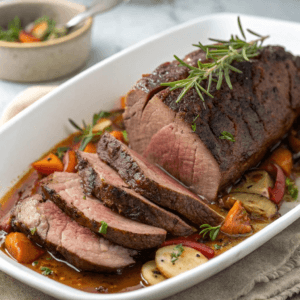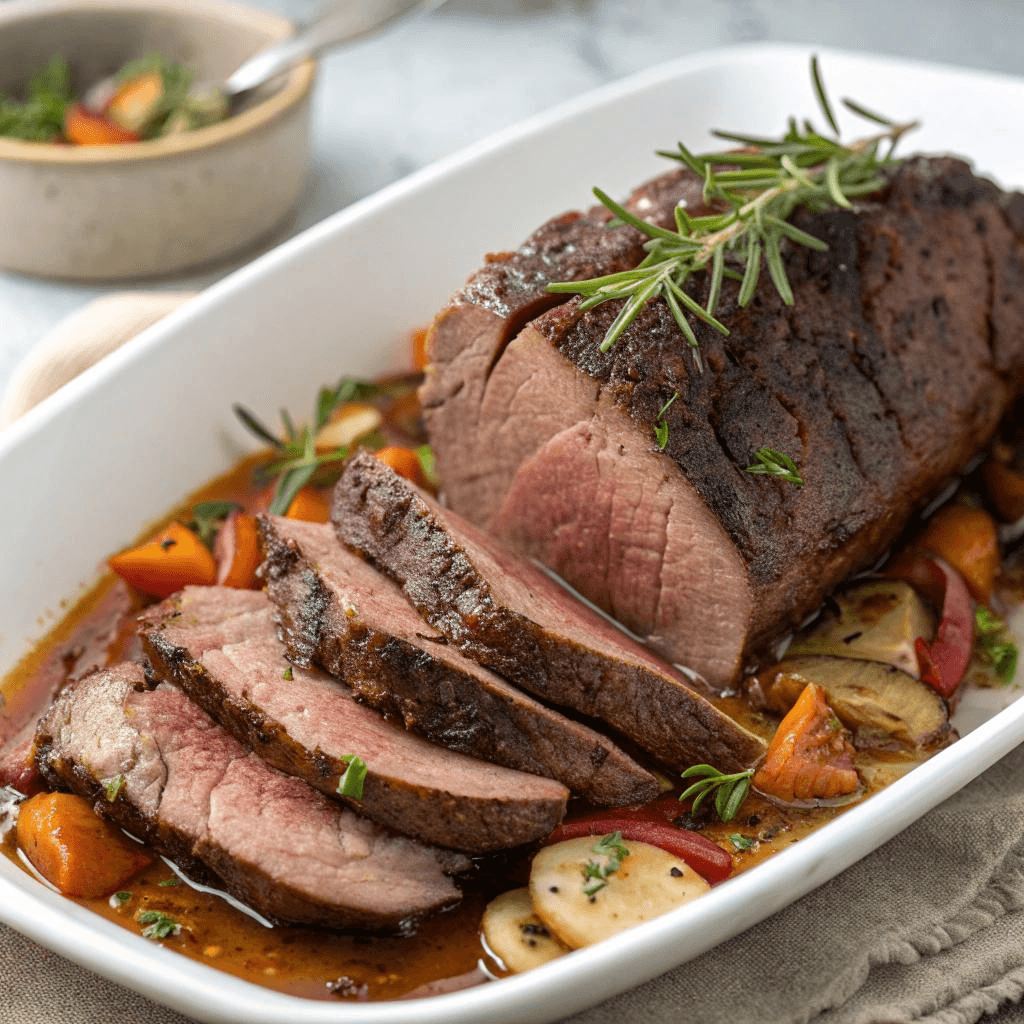Cooking beef heart recipes is an art that combines creativity with resourcefulness. This often-overlooked cut of meat offers a unique culinary experience, providing both flavor and nutritional value. Include this ingredient into your meals is an excellent way to diversify your protein sources. The beef heart prepared in a very simple method can be a delicacy comparable to the traditional cuts. Knowing how to prepare and cook beef heart will ultimately make it a staple in your kitchen. Quick sauté to slow cooking: it can be done in so many ways.
Want more creative ways to cook organ meat? Dive into this beef heart recipes collection.
Table of Contents

Grilled Beef Heart Skewers
Equipment
- mixing bowl
- Whisk
- grill or grill pan
- skewers metal or soaked wooden
- knife for trimming and cubing heart
Ingredients
- 500 g beef heart, cleaned and cubed
- 3 tbsp soy sauce
- 1 tbsp honey
- 2 cloves garlic, minced
- 1 tbsp olive oil
- 1 tsp black pepper
- 1 bell pepper, cut into chunks (optional)
- 1 red onion, cut into chunks (optional)
- 4 wooden or metal skewers
Instructions
- In a bowl, whisk together soy sauce, honey, minced garlic, olive oil, and black pepper to make the marinade.
- Add cubed beef heart to the bowl and toss to coat evenly. Cover and marinate in the fridge for at least 4 hours.
- If using wooden skewers, soak them in water for 30 minutes to prevent burning.
- Thread marinated beef heart pieces onto skewers, alternating with optional bell pepper and onion chunks.
- Preheat grill to medium-high. Grill skewers for 4–5 minutes per side until lightly charred and cooked through.
- Remove from grill and serve hot with your favorite dipping sauce or over grains.
Notes
- For extra flavor, try adding bell peppers, red onions, or zucchini between meat chunks.
- Don’t skip the marinating step — it ensures tenderness and depth.
- Serve with chimichurri or garlic aioli for a bold flavor punch.
Why Beef Deserves a Place in Your Kitchen
Incorporating beef heart recipes into your culinary repertoire isn’t just about trying something new; it’s about making smarter choices. Compared to popular cuts of beef, beef heart is comparatively affordable and, most importantly, a partner with the environment. It has a rich, yet relatively tasteless texture that makes it versatile and adaptable for various menus. Also, it’s a great way to carry through with the nose-to-tail food philosophy, helping to reduce waste while maximizing nutrition. When well prepared, beef heart is a favorite in the family, preparing a satisfying substitute for those regular meals.
Exploring the Nutritional Benefits of Beef Heart
Beef heart is a nutrient-dense food packed with essential vitamins and minerals. It’s particularly high in iron, which supports energy production, and coenzyme Q10, known for its heart health benefits. Beef heart recipes also offer an excellent source of B vitamins, which are very important for maintaining optimal brain function. Its protein content rivals that of more common cuts, providing muscle-building nutrients without excessive fat. Including beef heart in your meals is an effective way to boost your diet without compromising on taste.
How to Choose the Best Quality Beef Heart
The chief determinant of making a perfect dish is select from among the choices of beef heart. Always pack a fresh or frozen heart in deep ruby-red color. Be sure there is no sign of discoloration or bad smells. If possible, purchase from a trusted local butcher who can provide additional tips. Beef heart recipes often start with the best ingredients, so quality should never be compromised. For those seeking organic options, grass-fed beef hearts are a great choice, offering enhanced flavor and higher nutritional content.
Essential Tips for Cleaning and Preparing Beef Heart
Proper preparation ensures your beef heart recipes turn out tender and delicious. Start by rinsing the heart under cold water to remove any residual blood. Trim away fat, connective tissue, and veins using a sharp knife for cleaner cuts. Slicing the beef heart into uniform pieces ensures even cooking, no matter the method you choose. For first-timers, marinating the heart can enhance tenderness and infuse the meat with bold flavors. Taking these steps guarantees a successful outcome.
- Always use a sharp knife for precise trimming.
- Rinse thoroughly to remove impurities.
- Cut into smaller portions for faster cooking.
Not sure how to prep it? Learn whether soaking beef heart is really necessary before cooking.
Marination Techniques to Enhance Flavor and Tenderness
Marinating is crucial for delicious beef heart recipes. Acidic ingredients like vinegar, juice from citrus fruits, or yogurt can tenderize the meat while flavoring it. Mix them with spices, garlic, and olive oil for a balanced marinade. To give the heart the best results, marinate it for an 4-6 hour period. Two ingredients may be named patience and tenderness, as well as flavor and enjoyment at the table.
Grilling Techniques for a Smoky and Flavorful Beef Heart
Grilling is hottest when preparing beef heart recipes. The heat causes the sugar in the meat to caramelize and form a smoky crust while locking in juices. Cut the heart into thin slices to grill evenly. Preheat the grill to medium-high to avoid sticking. Flip the pieces quickly to avoid overcooking. With proper seasoning, grilled beef heart becomes an irresistible centerpiece for any meal.
If you’ve tried liver before, find out how beef heart stacks up in taste and texture.
Braising Beef Heart for a Tender and Juicy Dish
When it comes to getting recipes from beef heart, braising is the most preferred method. It makes tender and flavorful meats. Slow cooking means simmering the meat in a liquid base of strong bovine broth. Better include flavor enhancers like aromatic vegetables in the form of onion, garlic, and carrot. Leave it on low flame for 2-3 hours so that the heart is seeping with all the flavor. This produces a melt-in-the-mouth dish that can be served with several sides.
Slow Cooking Methods for Busy Days
For hassle-free beef heart recipes, a slow cooker is an excellent tool. Simply add the cleaned and trimmed heart along with your choice of vegetables, spices, and broth. Set the slow cooker on low heat and let it work its magic over 6-8 hours. This method is ideal for creating stews or shredded beef heart for tacos and sandwiches. The long cooking time ensures a tender and flavorful outcome with minimal effort.
Classic Pan-Seared Beef Heart
Pan-searing is a quick and effective way to prepare beef heart recipes. Heat the skillet with some butter or oil until it’s sizzling hot. Add thinly sliced pieces of beef heart and cook for 2-3 minutes per side. This method creates a golden-brown crust while keeping the inside juicy. Add some salt, pepper, and a litlle bit of lemon for a simple satisfying dish that highlights the natural flavor of the beef heart.
How to Make a Hearty Beef Stew
A hearty beef heart stew is the ultimate comfort food. Start by browning cubed pieces of beef heart in a pot with olive oil. Add diced onions, carrots, and potatoes for a balanced texture. Add beef stock and seasoning with bay leaves, thyme, and paprika. let the stew to simmer for 2 to 3 hours over low flame. This method allows the meat to tenderize and the melted flavors to mingle, making it an excellent dish for a chilly evening.
Creating Grilled Beef Heart Skewers for Appetizers
Grilled beef heart skewers are an excellent appetizer for gatherings. Cut the heart into bite-sized chunks and marinate with a blend of soy sauce, some garlic and honey. Thread the pieces onto skewers with vegetables like bell peppers and onions. Grill over medium heat until lightly charred. These skewers are not only visually attracting but also packed with flavor, making them a hit at any event.
International Recipes Featuring Beef Heart
Beef heart recipes hold a treasured place in various international cuisines. In Peru, anticuchos—grilled beef heart skewers—are a staple, marinated in a blend of vinegar, garlic, and Peruvian spices. This dish highlights bold flavors with a hint of smokiness from the grill.French cuisine turns beef heart into a high-end dish by slow cooking it in red wine, shallots, and herbs, resulting in a rich, velvety finish. In Japan, it is very common for very thin slices of beef heart to be served yakitori, grilled on a skewer and coated with a sweet soy glaze. Across cultures, preparation reflects local tastes, rendering beef heart a globally adaptable ingredient.
Perfect Side Dishes to Pair with Beef Heart
Pairing beef heart recipes with complementary sides can elevate the overall dining experience. Creamy mashed potatoes provide a rich contrast to the heart’s robust texture. Lightly roasted vegetables, such as carrots and parsnips, to bring out the natural sweetness in the dish. It not only adds a good nutty quality to the meal, but these grains absorb all juices very well, like quinoa or farro. For a lighter note, perhaps one can simply toss a fresh green salad with citrus vinaigrette. Or some garlic aioli or tart chimichurri will add to the sensory profile as each mouthful is relished.
Storage Tips to Keep Your Beef Heart Fresh
A good storage is essential for maintaining the quality of your beef heart recipes. If you’re not cooking the beef heart immediately, refrigerate it within two hours of purchase. Keep it in an airtight container or wrapped securely in butcher paper. Raw beef heart lasts up to two days in the refrigerator. For longer storage, freeze it in a vacuum-sealed bag or heavy-duty freezer wrap to prevent freezer burn. Frozen beef heart remains fresh for up to three months. When reheating cooked beef heart, do so gently to retain its texture and flavor, ensuring a satisfying meal every time.
Debunking Myths About Cooking Beef Heart
There are multiple myths surrounding beef heart recipes, thus discouraging people from going for this odd ingredient. For instance, one common belief is that beef heart tastes so gamey; in reality, it just tastes mild and beefy, like the flavor of any leaner cuts, such as sirloin. Another myth suggests that beef heart is too tough to enjoy, but proper cooking techniques, such as marinating or slow cooking, result in a tender texture. Some assume it’s difficult to cook, yet beef heart is as versatile and straightforward as any other meat. Dispelling these myths opens the door to a world of culinary possibilities.
Curious why beef heart is so underrated? Here’s an honest breakdown of why more people don’t eat it.
Health Benefits of Incorporating Beef Heart in Your Diet
Adding beef heart recipes to your diet provides a wealth of nutritional benefits. Beef heart is a powerhouse of protein, essential for muscle repair and growth. It’s also rich in iron, which supports energy production and prevents anemia. The high levels of coenzyme Q10 (CoQ10) promote heart health by improving energy metabolism at the cellular level. Additionally, beef heart contains significant amounts of B vitamins, including B12, which are crucial for neurological health. With its low fat content, it’s a leaner option compared to many traditional cuts, making it ideal for health-conscious eaters.
Beef heart isn’t just tasty—it’s packed with nutrients. Here’s what makes it healthy.
Delicious Beef Heart Dishes for Every Occasion
Whether it’s a casual family dinner or a festive celebration, beef heart recipes can adapt to any occasion. For quick weeknight meals, try pan-seared beef heart slices paired with a side salad. Hosting a backyard barbecue? Grilled beef heart skewers offer a smoky, savory bite.A warm beef heart stew fragrant with vegetables as well as herbs is comforting on the cooler days. Mini beef heart tacos with freshly prepared salsa make excellent-can appetizers. Unquestionably, beef heart is very adaptable and you can fit it into any menu.
FAQs :
Is beef heart good for you?
Absolutely! Beef heart is a nutritional powerhouse. It’s rich in protein, iron, zinc, and B vitamins—especially B12—while being lower in fat than many other cuts of beef. Plus, it contains CoQ10, which supports heart and cellular health. So yes, beef heart is not just good for you—it’s a smart, nutrient-dense choice.
Can I eat beef heart rare?
Yes, but with caution. If it’s high-quality and handled safely, lightly cooking the beef heart to a medium-rare doneness can keep it juicy and tender. Just make sure the outside is well-cooked to reduce any food safety risks.
How do I cook beef heart?
To bring out the best in beef heart, try slicing it thin and cooking it quickly over high heat—like in a hot skillet or on the grill. Want it extra tender? Slow-cook it with broth and aromatics until it melts in your mouth. Either way, seasoning and marinating go a long way in boosting flavor.


5 thoughts on “Unlock the Flavor and Benefits of Beef Heart Recipes”